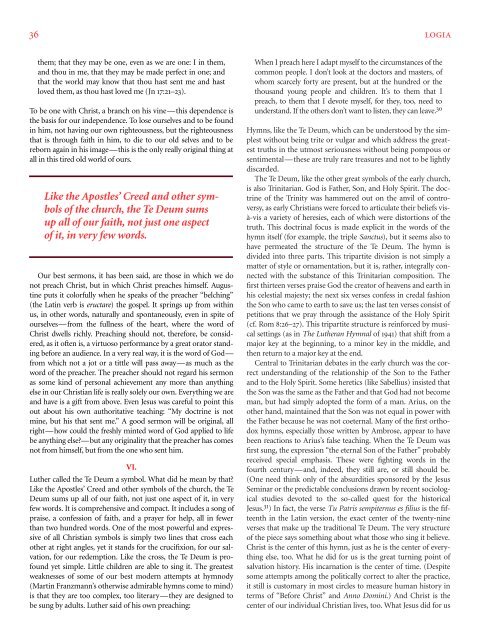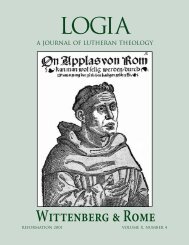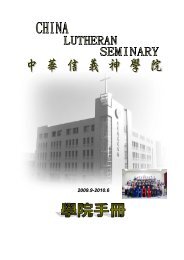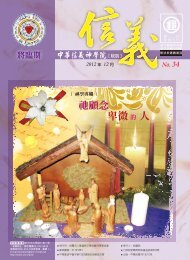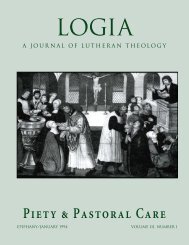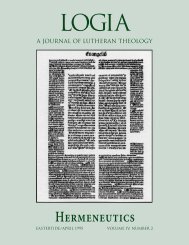05-4 Theology of the..
05-4 Theology of the..
05-4 Theology of the..
Create successful ePaper yourself
Turn your PDF publications into a flip-book with our unique Google optimized e-Paper software.
36 LOGIA<br />
<strong>the</strong>m; that <strong>the</strong>y may be one, even as we are one: I in <strong>the</strong>m,<br />
and thou in me, that <strong>the</strong>y may be made perfect in one; and<br />
that <strong>the</strong> world may know that thou hast sent me and hast<br />
loved <strong>the</strong>m, as thou hast loved me (Jn 17:21–23).<br />
To be one with Christ, a branch on his vine—this dependence is<br />
<strong>the</strong> basis for our independence. To lose ourselves and to be found<br />
in him, not having our own righteousness, but <strong>the</strong> righteousness<br />
that is through faith in him, to die to our old selves and to be<br />
reborn again in his image—this is <strong>the</strong> only really original thing at<br />
all in this tired old world <strong>of</strong> ours.<br />
Like <strong>the</strong> Apostles’ Creed and o<strong>the</strong>r symbols<br />
<strong>of</strong> <strong>the</strong> church, <strong>the</strong> Te Deum sums<br />
up all <strong>of</strong> our faith, not just one aspect<br />
<strong>of</strong> it, in very few words.<br />
nb<br />
Our best sermons, it has been said, are those in which we do<br />
not preach Christ, but in which Christ preaches himself. Augustine<br />
puts it colorfully when he speaks <strong>of</strong> <strong>the</strong> preacher “belching”<br />
(<strong>the</strong> Latin verb is eructare) <strong>the</strong> gospel. It springs up from within<br />
us, in o<strong>the</strong>r words, naturally and spontaneously, even in spite <strong>of</strong><br />
ourselves—from <strong>the</strong> fullness <strong>of</strong> <strong>the</strong> heart, where <strong>the</strong> word <strong>of</strong><br />
Christ dwells richly. Preaching should not, <strong>the</strong>refore, be considered,<br />
as it <strong>of</strong>ten is, a virtuoso performance by a great orator standing<br />
before an audience. In a very real way, it is <strong>the</strong> word <strong>of</strong> God—<br />
from which not a jot or a tittle will pass away—as much as <strong>the</strong><br />
word <strong>of</strong> <strong>the</strong> preacher. The preacher should not regard his sermon<br />
as some kind <strong>of</strong> personal achievement any more than anything<br />
else in our Christian life is really solely our own. Everything we are<br />
and have is a gift from above. Even Jesus was careful to point this<br />
out about his own authoritative teaching: “My doctrine is not<br />
mine, but his that sent me.” A good sermon will be original, all<br />
right—how could <strong>the</strong> freshly minted word <strong>of</strong> God applied to life<br />
be anything else—but any originality that <strong>the</strong> preacher has comes<br />
not from himself, but from <strong>the</strong> one who sent him.<br />
VI.<br />
Lu<strong>the</strong>r called <strong>the</strong> Te Deum a symbol. What did he mean by that<br />
Like <strong>the</strong> Apostles’ Creed and o<strong>the</strong>r symbols <strong>of</strong> <strong>the</strong> church, <strong>the</strong> Te<br />
Deum sums up all <strong>of</strong> our faith, not just one aspect <strong>of</strong> it, in very<br />
few words. It is comprehensive and compact. It includes a song <strong>of</strong><br />
praise, a confession <strong>of</strong> faith, and a prayer for help, all in fewer<br />
than two hundred words. One <strong>of</strong> <strong>the</strong> most powerful and expressive<br />
<strong>of</strong> all Christian symbols is simply two lines that cross each<br />
o<strong>the</strong>r at right angles, yet it stands for <strong>the</strong> crucifixion, for our salvation,<br />
for our redemption. Like <strong>the</strong> cross, <strong>the</strong> Te Deum is pr<strong>of</strong>ound<br />
yet simple. Little children are able to sing it. The greatest<br />
weaknesses <strong>of</strong> some <strong>of</strong> our best modern attempts at hymnody<br />
(Martin Franzmann’s o<strong>the</strong>rwise admirable hymns come to mind)<br />
is that <strong>the</strong>y are too complex, too literary—<strong>the</strong>y are designed to<br />
be sung by adults. Lu<strong>the</strong>r said <strong>of</strong> his own preaching:<br />
When I preach here I adapt myself to <strong>the</strong> circumstances <strong>of</strong> <strong>the</strong><br />
common people. I don’t look at <strong>the</strong> doctors and masters, <strong>of</strong><br />
whom scarcely forty are present, but at <strong>the</strong> hundred or <strong>the</strong><br />
thousand young people and children. It’s to <strong>the</strong>m that I<br />
preach, to <strong>the</strong>m that I devote myself, for <strong>the</strong>y, too, need to<br />
understand. If <strong>the</strong> o<strong>the</strong>rs don’t want to listen, <strong>the</strong>y can leave. 30<br />
Hymns, like <strong>the</strong> Te Deum, which can be understood by <strong>the</strong> simplest<br />
without being trite or vulgar and which address <strong>the</strong> greatest<br />
truths in <strong>the</strong> utmost seriousness without being pompous or<br />
sentimental—<strong>the</strong>se are truly rare treasures and not to be lightly<br />
discarded.<br />
The Te Deum, like <strong>the</strong> o<strong>the</strong>r great symbols <strong>of</strong> <strong>the</strong> early church,<br />
is also Trinitarian. God is Fa<strong>the</strong>r, Son, and Holy Spirit. The doctrine<br />
<strong>of</strong> <strong>the</strong> Trinity was hammered out on <strong>the</strong> anvil <strong>of</strong> controversy,<br />
as early Christians were forced to articulate <strong>the</strong>ir beliefs visà-vis<br />
a variety <strong>of</strong> heresies, each <strong>of</strong> which were distortions <strong>of</strong> <strong>the</strong><br />
truth. This doctrinal focus is made explicit in <strong>the</strong> words <strong>of</strong> <strong>the</strong><br />
hymn itself (for example, <strong>the</strong> triple Sanctus), but it seems also to<br />
have permeated <strong>the</strong> structure <strong>of</strong> <strong>the</strong> Te Deum. The hymn is<br />
divided into three parts. This tripartite division is not simply a<br />
matter <strong>of</strong> style or ornamentation, but it is, ra<strong>the</strong>r, integrally connected<br />
with <strong>the</strong> substance <strong>of</strong> this Trinitarian composition. The<br />
first thirteen verses praise God <strong>the</strong> creator <strong>of</strong> heavens and earth in<br />
his celestial majesty; <strong>the</strong> next six verses confess in credal fashion<br />
<strong>the</strong> Son who came to earth to save us; <strong>the</strong> last ten verses consist <strong>of</strong><br />
petitions that we pray through <strong>the</strong> assistance <strong>of</strong> <strong>the</strong> Holy Spirit<br />
(cf. Rom 8:26–27). This tripartite structure is reinforced by musical<br />
settings (as in The Lu<strong>the</strong>ran Hymnal <strong>of</strong> 1941) that shift from a<br />
major key at <strong>the</strong> beginning, to a minor key in <strong>the</strong> middle, and<br />
<strong>the</strong>n return to a major key at <strong>the</strong> end.<br />
Central to Trinitarian debates in <strong>the</strong> early church was <strong>the</strong> correct<br />
understanding <strong>of</strong> <strong>the</strong> relationship <strong>of</strong> <strong>the</strong> Son to <strong>the</strong> Fa<strong>the</strong>r<br />
and to <strong>the</strong> Holy Spirit. Some heretics (like Sabellius) insisted that<br />
<strong>the</strong> Son was <strong>the</strong> same as <strong>the</strong> Fa<strong>the</strong>r and that God had not become<br />
man, but had simply adopted <strong>the</strong> form <strong>of</strong> a man. Arius, on <strong>the</strong><br />
o<strong>the</strong>r hand, maintained that <strong>the</strong> Son was not equal in power with<br />
<strong>the</strong> Fa<strong>the</strong>r because he was not coeternal. Many <strong>of</strong> <strong>the</strong> first orthodox<br />
hymns, especially those written by Ambrose, appear to have<br />
been reactions to Arius’s false teaching. When <strong>the</strong> Te Deum was<br />
first sung, <strong>the</strong> expression “<strong>the</strong> eternal Son <strong>of</strong> <strong>the</strong> Fa<strong>the</strong>r” probably<br />
received special emphasis. These were fighting words in <strong>the</strong><br />
fourth century—and, indeed, <strong>the</strong>y still are, or still should be.<br />
(One need think only <strong>of</strong> <strong>the</strong> absurdities sponsored by <strong>the</strong> Jesus<br />
Seminar or <strong>the</strong> predictable conclusions drawn by recent sociological<br />
studies devoted to <strong>the</strong> so-called quest for <strong>the</strong> historical<br />
Jesus. 31 ) In fact, <strong>the</strong> verse Tu Patris sempiternus es filius is <strong>the</strong> fifteenth<br />
in <strong>the</strong> Latin version, <strong>the</strong> exact center <strong>of</strong> <strong>the</strong> twenty-nine<br />
verses that make up <strong>the</strong> traditional Te Deum. The very structure<br />
<strong>of</strong> <strong>the</strong> piece says something about what those who sing it believe.<br />
Christ is <strong>the</strong> center <strong>of</strong> this hymn, just as he is <strong>the</strong> center <strong>of</strong> everything<br />
else, too. What he did for us is <strong>the</strong> great turning point <strong>of</strong><br />
salvation history. His incarnation is <strong>the</strong> center <strong>of</strong> time. (Despite<br />
some attempts among <strong>the</strong> politically correct to alter <strong>the</strong> practice,<br />
it still is customary in most circles to measure human history in<br />
terms <strong>of</strong> “Before Christ” and Anno Domini.) And Christ is <strong>the</strong><br />
center <strong>of</strong> our individual Christian lives, too. What Jesus did for us


